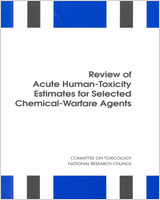NCBI Bookshelf. A service of the National Library of Medicine, National Institutes of Health.
No reliable acute-exposure1 standards have been established for the particular purpose of protecting soldiers from toxic exposures to chemical warfare (CW) agents. Some human-toxicity estimates are available for the most common CW agents--organophosphorus nerve agents and vesicants; however, most of those estimates were developed for offensive purposes (that is, to kill or incapacitate the enemy) and were intended to be interim values only. Because of the possibility of a chemical attack by a foreign power, the Army's Office of the Surgeon General asked the Army's Chemical Defense Equipment Process Action Team (CDEPAT) to review the toxicity data for the nerve agents GA (tabun), GB(sarin), GD (soman), GF, and VX, and the vesicant agent sulfur mustard (HD) and to establish a set of exposure limits that would be useful in protecting soldiers from toxic exposures to those agents. This report is an independent review of the CDEPAT report to determine the scientific validity of the proposed estimates.
Contents
- Subcommittee on Toxicity Values for Selected Nerve and vesicant Agents
- Committee on Toxicology
- Board on Environmental Studies and Toxicology
- Commission on Life Sciences
- Other Recent Reports of the Board on Environmental Studies and Toxicology
- Other Recent Reports of the Committee on Toxicology
- [The National Academies]
- Preface
- Summary
- 1. Introduction and Background
- 2. Review of Acute Human-Toxicity Estimates for GA (Tabun)
- 3. Review of Acute Human-Toxicity Estimates for GB (Sarin)
- 4. Review of Acute Human-Toxicity Estimates for GD (Soman)
- 5. Review of Acute Human-Toxicity Estimates for GF
- 6. Review of Acute Human-Toxicity Estimates for VX
- 7. Review of Acute Human-Toxicity Estimates for HD
- 8. Evaluation of the Risk-Estimation Procedures Used in the CDEPAT Report
- References
- Glossary
- Appendix Offensive Versus Defensive Use of Human-Toxicity Estimates for CW Agents
The project was supported by contract DAMD 17-89-C-9086 between the National Academy of Sciences and the U.S. Department of Defense. Any opinions, findings, conclusions, or recommendations expressed in this publication are those of the author(s) and do not necessarily reflect the view of the organizations or agencies that provided support for this project.
NOTICE: The project that is the subject of this report was approved by the Governing Board of the National Research Council, whose members are drawn from the councils of the National Academy of Sciences, the National Academy of Engineering, and the Institute of Medicine. The members of the committee responsible for the report were chosen for their special competences and with regard for appropriate balance.
This report has been reviewed by a group other than the authors according to procedures approved by a Report Review Committee consisting of members of the National Academy of Sciences, the National Academy of Engineering, and the Institute of Medicine.
- NLM CatalogRelated NLM Catalog Entries
- Review of the U.S. Army's health risk assessments for oral exposure to six chemical-warfare agents. Introduction.[J Toxicol Environ Health A. 2000]Review of the U.S. Army's health risk assessments for oral exposure to six chemical-warfare agents. Introduction.. J Toxicol Environ Health A. 2000 Mar; 59(5-6):281-526.
- Improving Quantification of tabun, sarin, soman, cyclosarin, and sulfur mustard by focusing agents: A field portable gas chromatography-mass spectrometry study.[J Chromatogr A. 2021]Improving Quantification of tabun, sarin, soman, cyclosarin, and sulfur mustard by focusing agents: A field portable gas chromatography-mass spectrometry study.Kelly JT, Qualley A, Hughes GT, Rubenstein MH, Malloy TA, Piatkowski T. J Chromatogr A. 2021 Jan 11; 1636:461784. Epub 2020 Dec 13.
- Review The sources, fate, and toxicity of chemical warfare agent degradation products.[Environ Health Perspect. 1999]Review The sources, fate, and toxicity of chemical warfare agent degradation products.Munro NB, Talmage SS, Griffin GD, Waters LC, Watson AP, King JF, Hauschild V. Environ Health Perspect. 1999 Dec; 107(12):933-74.
- Review Review of the U.S. Army's Health Risk Assessments For Oral Exposure to Six Chemical-Warfare Agents[ 1999]Review Review of the U.S. Army's Health Risk Assessments For Oral Exposure to Six Chemical-Warfare AgentsNational Research Council (US) Subcommittee on Chronic Reference Doses for Selected Chemical Warfare Agents. 1999
- Liquid chromatography electrospray tandem mass spectrometric and desorption electrospray ionization tandem mass spectrometric analysis of chemical warfare agents in office media typically collected during a forensic investigation.[J Chromatogr A. 2006]Liquid chromatography electrospray tandem mass spectrometric and desorption electrospray ionization tandem mass spectrometric analysis of chemical warfare agents in office media typically collected during a forensic investigation.D'Agostino PA, Hancock JR, Chenier CL, Lepage CR. J Chromatogr A. 2006 Mar 31; 1110(1-2):86-94. Epub 2006 Feb 9.
- Review of Acute Human-Toxicity Estimates for Selected Chemical-Warfare AgentsReview of Acute Human-Toxicity Estimates for Selected Chemical-Warfare Agents
Your browsing activity is empty.
Activity recording is turned off.
See more...
